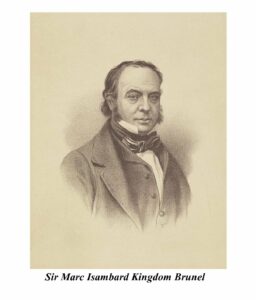
Many people have said that Isombard Kingdom Brunel was our greatest engineer, which led me to wonder from where he came, did his background help him? The answer is a great big, yes.
His father, Sir Marc Brunel, was an amazing engineer, of whom nobody has heard.
He was born in Hacqueville, Normandy, France, but at 25 he was on the wrong side during the French Revolution so to escape the Guillotine he fleed to America. Now when he got there he was so successful that by 1796 he was appointed Chief Engineer of New York.
That isn’t the end of the story
He invented and created things that even today we live with.
For example:
- He invented the Wellington Boot, developed for soldiers in the Peninsular Campaign, which we still use today.
- In 1818 he patented a tunnelling shield. A reinforced shield of cast iron in which miners would work in separate compartments, digging at the tunnel-face. Periodically the shield would be driven forward by large jacks, while the tunnel surface behind it would be lined with brick. This system is still used today, for example it was used to drill the Channel Tunnel.
- He designed and built the Rotherhithe Tunnel, which, you guessed it, is still in use today. Work began in February 1825, after several stops and starts it was finally opened on November 1843. Interestingly for his work on the tunnel he was knighted by Queen Victoria on 24 March 1841.Today is it in daily use as part of the London Underground Network.
Amazingly having done all that, still, nobody has heard of him!
Three years later he came to London
Why, well, to marry his sweetheart, Sophia Kingdom. You see, he had to leave her in Rouen, from where he had to flee and because he had the Revolutionaries claimed she was an English spy, and had sentenced her to be executed, fortunately, the fall of Robespierre allowed her to get out and travel to London.
His pulley design paid for his travel to London
It is belived that Brunel’s ship to London was paid for by the British Ambassador, who on learning of Brunel’s design to automate pulley production put him on the next ship to England. As soon as he arrived, he found Sophia and on 1 November 1799, they were married.
The Wellington Boot
Once here he learnt the problem the Duke of Wellington’s troops were having marching through mud, he solved it by producing the “Wellington Boot”. These he made and sold, along with pulleys, in volume to the army. Unfortunately, when the war ended, so did his contract, he went bankrupt and was sent to debtor’s prison. The story goes that the Duke was so thankful for the boots that he paid his debts, getting him out of debtors prison.
Then came the Rotherhithe Tunnel
However, his greatest success was the Rotherhithe Tunnel. Originally started in 1805 but stopped in 1807 as the roof kept falling in! In 1818 Brunel came up with the idea of a tunnelling shield, a reinforced shield of cast iron allowing miners to work in separate compartments, digging at the tunnel-face, then periodically driving it forward. Brunel’s invention is still the basis of all subsequent tunnelling shields. However, the tunnel still had many problems, mainly financial, and it was only on 25 March 1843 that it opened, but before that, on 24th March 1841, Brunel was knighted by Queen Victoria.
He survived until his death at 80 on 12 December 1849. What a great man, who was in fact as great an engineer as his son, which I think is increadable.
Isn’t History fun!
10 questions to discuss:
- Beyond the Wellington Boot and tunneling shield, what other notable inventions or projects did Marc Brunel contribute to during his career?
- Given the dangers of the French Revolution, what specific actions did Marc Brunel take to escape execution and reach America?
- How did Marc Brunel’s success as Chief Engineer in New York influence his son Isambard’s future aspirations and path?
- The blog mentions several challenges faced during the construction of the Rotherhithe Tunnel. What were some of the most significant engineering obstacles overcome by Marc Brunel and his team?
- Beyond the financial issues mentioned, were there any other social or political factors that impacted the construction and reception of the Rotherhithe Tunnel?
- How did Isambard Kingdom Brunel build upon his father’s tunnelling shield design, and what other engineering advancements did he incorporate into his own projects?
- Considering their shared passion for engineering, did Isambard and Marc Brunel collaborate on any projects or share professional advice throughout their careers?
- The blog suggests that both father and son deserve recognition for their engineering achievements. How do you think their individual styles and approaches to engineering differed?
- Beyond the inventions mentioned, are there any other ways in which the work of Marc and Isambard Brunel continues to impact our lives today?
- If you could conduct further research on either Marc or Isambard Brunel, what aspect of their lives or careers would you find most interesting to explore?
These questions delve deeper into the blog’s content and encourage critical thinking about the Brunels’ legacies and contributions to engineering history. Feel free to adapt or expand on them based on your specific interests and the information available.
For more about him:
https://www.encyclopedia.com/history/news-wires-white-papers-and-books/sir-marc-isambard-brunel
https://grants.fnl.org.uk/archive-sir-marc-isambard-brunel-1769-1849-relating-thames-tunnel
https://www.britannica.com/technology/engineering
© Tony Dalton

